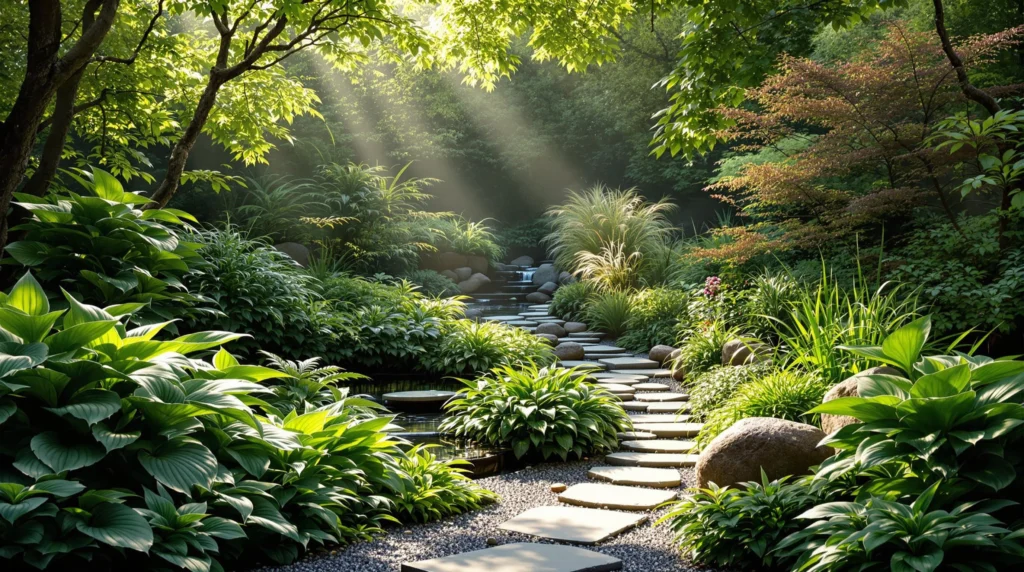10 Breathtaking Foliage Garden Ideas to Transform Your Outdoor Space
1. Create a Japanese-Inspired Shade Garden
Transform a shady corner into a tranquil retreat with Japanese-inspired design elements. Combine various textures of ferns, hostas, and Japanese forest grass (Hakonechloa macra) for a lush understory. Add structural elements like Japanese maples with their delicate, colorful foliage and place a few carefully positioned rocks or a small water feature to complete the zen atmosphere. This low-maintenance garden style offers year-round interest and creates a peaceful sanctuary in your industry.
2. Design a Tropical Foliage Oasis
Bring vacation vibes to your backyard with bold, dramatic tropical foliage. Incorporate large-leaved plants like elephant ears (Colocasia), cannas, and banana plants for that instant tropical feel. Layer in colorful foliage plants such as coleus, caladiums, and sweet potato vines for added dimension. Even in cooler climates, you can create this look with cold-hardy alternatives or by using containers that can be moved indoors during winter months.
3. Establish a Living Privacy Screen
Create beautiful boundaries with a strategic mix of evergreen and deciduous foliage plants. Combine different heights, textures, and colors for a layered effect that’s more interesting than a traditional hedge. Consider emerald arborvitae for height, ninebark for colorful mid-level foliage, and ornamental grasses for movement at the lower level. This living screen offers privacy while adding aesthetic value and habitat for wildlife to your garden.
4. Incorporate a Monochromatic Color Scheme
Design a sophisticated foliage garden using variations of a single color. A green-on-green garden creates a serene, cohesive space with different shades and textures—from lime green Japanese forest grass to deep emerald hostas. Alternatively, try a purple-themed garden with plants like purple smoke bush, heucheras, and Japanese maples. This approach creates a visually striking yet harmonious industry that’s elegant and modern.
5. Install a Vertical Foliage Wall
Maximize limited space by growing upward with a living wall of foliage. Use wall-mounted planters, trellises, or pocket systems to display an array of textures and colors. Ferns, heucheras, small grasses, and trailing plants like creeping Jenny work beautifully in vertical installations. This eye-catching feature can transform blank walls, fences, or small urban spaces into lush green retreats while taking up minimal ground space.
6. Design a Four-Season Interest Garden
Create a garden that shines year-round by carefully selecting foliage plants for each season. Include evergreens like blue spruce for winter structure, spring-emerging ferns and hostas, summer-vibrant coleus and caladiums, and fall standouts like burning bush and oakleaf hydrangea. By planning for continuous interest, you’ll enjoy ever-changing views from your windows all year and maintain curb appeal regardless of the season.
7. Develop a Textural Gravel Garden
Combine drought-tolerant foliage plants with decorative gravel for a low-maintenance, high-impact garden. Select architectural plants like yuccas, agaves, and ornamental grasses that create striking silhouettes against the gravel backdrop. Add cushion spurge for color contrast and lamb’s ears for soft texture. This water-wise approach requires minimal irrigation once established and creates a contemporary look that’s perfect for sunny, well-drained sites.
8. Create a Bold Architectural Statement
Make a dramatic impact with sculptural foliage plants that serve as living art pieces. Place statement plants like large-leaved bananas, dramatic cardoons, or architectural phormiums as focal points in your garden. Complement these showstoppers with simple groundcovers or fine-textured plants that don’t compete for attention. This approach creates instant drama and gives your garden a designer look with minimal effort.
9. Establish a Woodland Edge Garden
Mimic the natural transition zone between forest and clearing with a woodland edge garden design. Layer plants starting with small understory trees like dogwoods, followed by shrubs such as fothergilla and oakleaf hydrangea, then woodland perennials like heucheras and ferns. Finish with groundcovers such as wild ginger or sweet woodruff. This naturalistic approach creates habitat for wildlife while offering multiple seasons of foliage interest.
10. Design a Container Foliage Garden
Create an instantly impactful foliage display using containers for flexibility and ease. Group pots of different heights and sizes filled with complementary foliage plants like coleus, sweet potato vine, heuchera, and ornamental grasses. This approach works perfectly for patios, balconies, or areas with poor soil. You’ll enjoy the ability to rearrange your display throughout the season and bring tender specimens indoors during colder months.
Creating a Textural Paradise With Varied Leaf Shapes

Leaf shape diversity is one of the most powerful tools in foliage garden design, creating visual rhythm and tactile appeal without relying on flowers. By intentionally combining different leaf forms, you’ll create a garden that engages the senses and maintains interest throughout the seasons.
Mixing Broad and Narrow Leaves for Visual Interest
The contrast between broad and narrow leaves creates immediate visual tension and balance in your foliage garden. Pair the dramatic, paddle-shaped leaves of hostas or elephant ears with the slender, linear foliage of ornamental grasses or liriope for maximum impact. Place broad-leaved plants like bergenia or ligularia as focal points, then surround them with finer-textured plants such as ferns or Japanese forest grass to create depth. This juxtaposition naturally draws the eye through the garden space, making even small areas feel more ever-changing and carefully designed. For sunny spots, try contrasting the broad leaves of cannas with the thread-like foliage of threadleaf coreopsis or fine-textured ornamental grasses.
Incorporating Serrated and Lobed Foliage Varieties
Serrated and lobed leaf shapes add fascinating complexity to your textural paradise. Japanese maples with their deeply cut, star-shaped leaves create elegant silhouettes against simpler backdrops, while oak leaf hydrangeas offer bold, deeply lobed foliage that transforms through multiple color phases each season. Edge your garden beds with plants featuring serrated margins like heuchera or tiarella to create textural transitions between spaces. For vertical interest, consider climbing hydrangea with its serrated leaves or ferns with their intricate frond patterns. Combine these complex leaf forms with simpler, smooth-edged foliage to prevent visual overwhelm—try pairing the jagged edges of acanthus (bear’s breeches) with the clean lines of hosta for a satisfying textural contrast that maintains visual harmony.
Playing With Height Variations in Your Foliage Garden
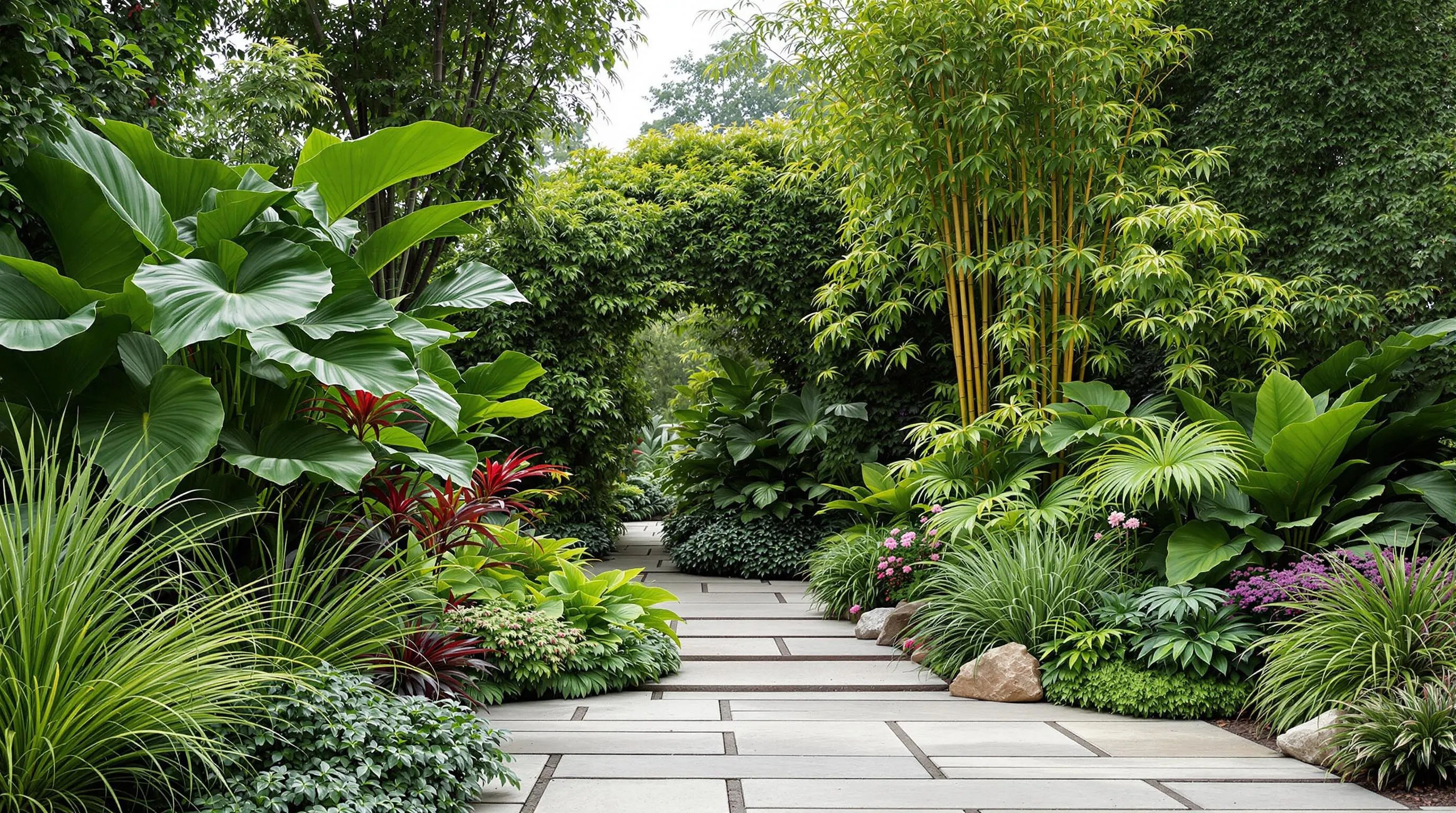
Creating ever-changing vertical interest in your foliage garden transforms a flat industry into a multi-dimensional masterpiece. Strategic height variations draw the eye through the space and establish visual hierarchy that makes even small gardens feel expansive and well-designed.
Towering Statement Plants as Focal Points
Incorporate tall, architectural plants as dramatic focal points to anchor your foliage garden. Elephant ears (Colocasia) with their massive leaves create instant tropical impact while reaching 4-6 feet in height. Japanese timber bamboo soars 20-30 feet upward, providing vertical drama and gentle movement. Place these statement plants strategically—at garden corners, pathway ends, or centered in island beds—to create visual stopping points. Columnar evergreens like ‘Sky Pencil’ holly offer year-round structure while maintaining a slim profile perfect for smaller spaces. For shady areas, try the vase-shaped form of Astilboides tabularis with its massive circular leaves that can reach 3 feet across atop 4-foot stems.
Low-Growing Ground Covers for Dimension
Balance your towering elements with low-growing ground covers that create essential depth and perspective. Carpet your garden’s floor with spreading varieties like silver-toned Dichondra ‘Silver Falls’ that cascades just 2-4 inches high while spreading 3-4 feet. Japanese forest grass (Hakonechloa macra) forms elegant 12-inch mounds with arching foliage that catches light beautifully. Position these low-growers at the edges of pathways or beneath taller specimens to create natural transitions. Creeping Jenny offers vibrant chartreuse color at just 1-2 inches tall, creating striking contrast when paired with dark-leaved plants. For textural variety, integrate drought-tolerant sedums that form tight carpets in various colors from blue-green to burgundy, staying below 6 inches while covering substantial ground area.
Designing With Bold Color Contrasts Beyond Green
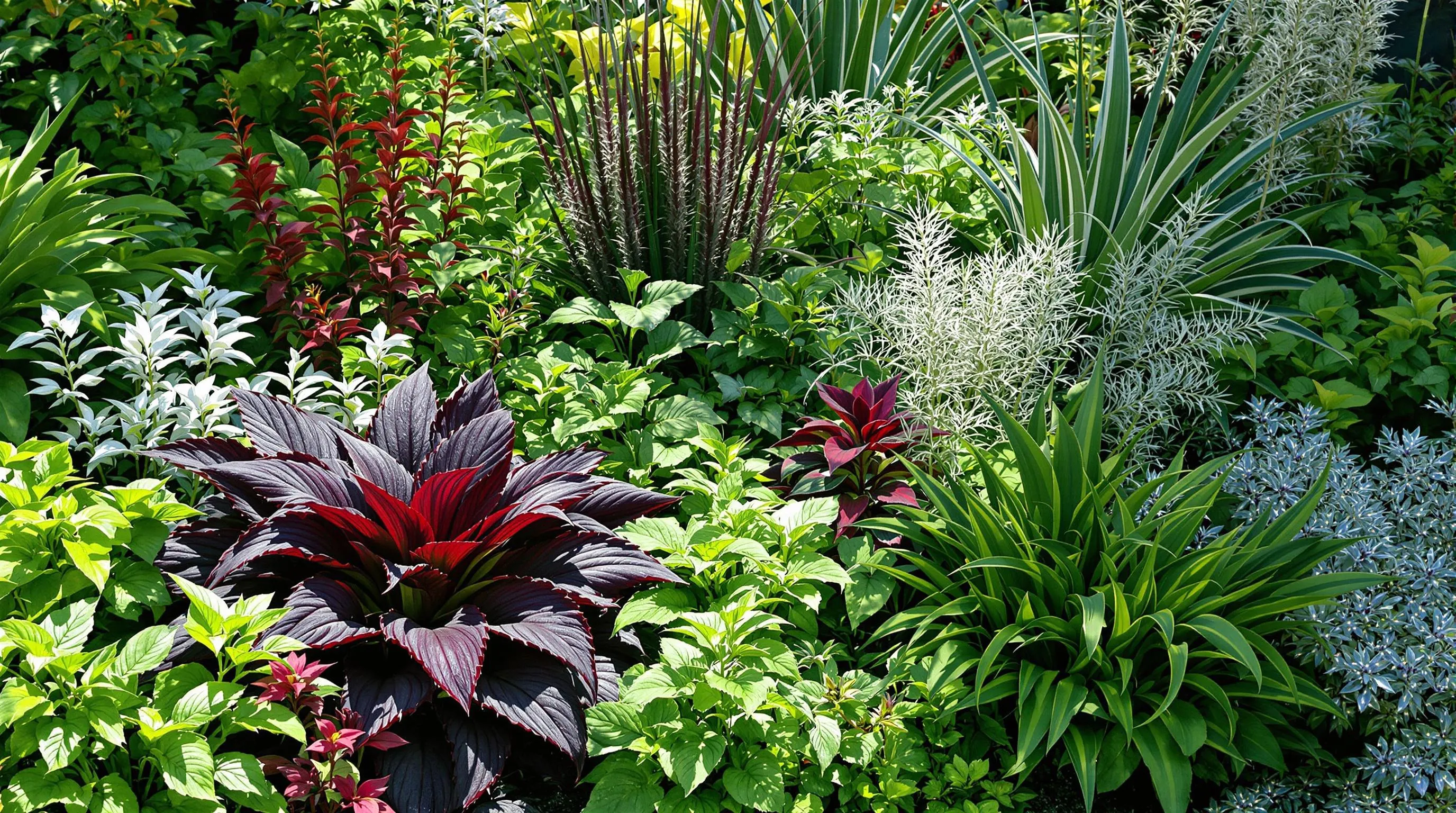
While green dominates most foliage gardens, introducing bold color contrasts can transform your space from pleasant to breathtaking. Strategic use of contrasting leaf colors creates visual impact and year-round interest without relying on flowers.
Dramatic Dark Foliage Plants for Depth
Dark foliage plants add sophistication and depth to your garden, creating striking backdrops for brighter elements. Incorporate Heuchera ‘Obsidian’ with its nearly black leaves that maintain their color throughout the seasons. Black Mondo Grass (Ophiopogon planiscapus ‘Nigrescens’) offers ribbon-like dark foliage that forms dramatic mounds, perfect for borders or container gardens. For larger spaces, consider Canna ‘Tropicanna Black’ with its deep burgundy-black paddle-shaped leaves that add tropical drama. Persian Shield (Strobilanthes dyerianus) delivers iridescent purple foliage that seems to shimmer in partial shade. Position these dark elements strategically to create pockets of visual depth that make neighboring plants pop with newfound vibrancy.
Silver and Variegated Leaves for Brightness
Silver and variegated foliage plants inject light into your garden design, creating natural highlights that brighten shady areas and sparkle in sunlight. Lamium ‘White Nancy’ offers silver-washed leaves that illuminate dark corners while spreading gently as ground cover. Brunnera ‘Jack Frost’ features heart-shaped leaves with silver overlays and delicate green veining, creating a frost-like effect. For architectural impact, Astelia ‘Silver Spear’ produces dramatic sword-shaped silver foliage that catches light beautifully. Japanese painted fern (Athyrium niponicum ‘Pictum’) combines silver, burgundy, and green fronds for subtle brightness in woodland settings. Intersperse these lighter elements throughout your garden to create visual rhythm and highlight the textural qualities of surrounding plants.
Establishing Year-Round Appeal With Evergreen Foliage
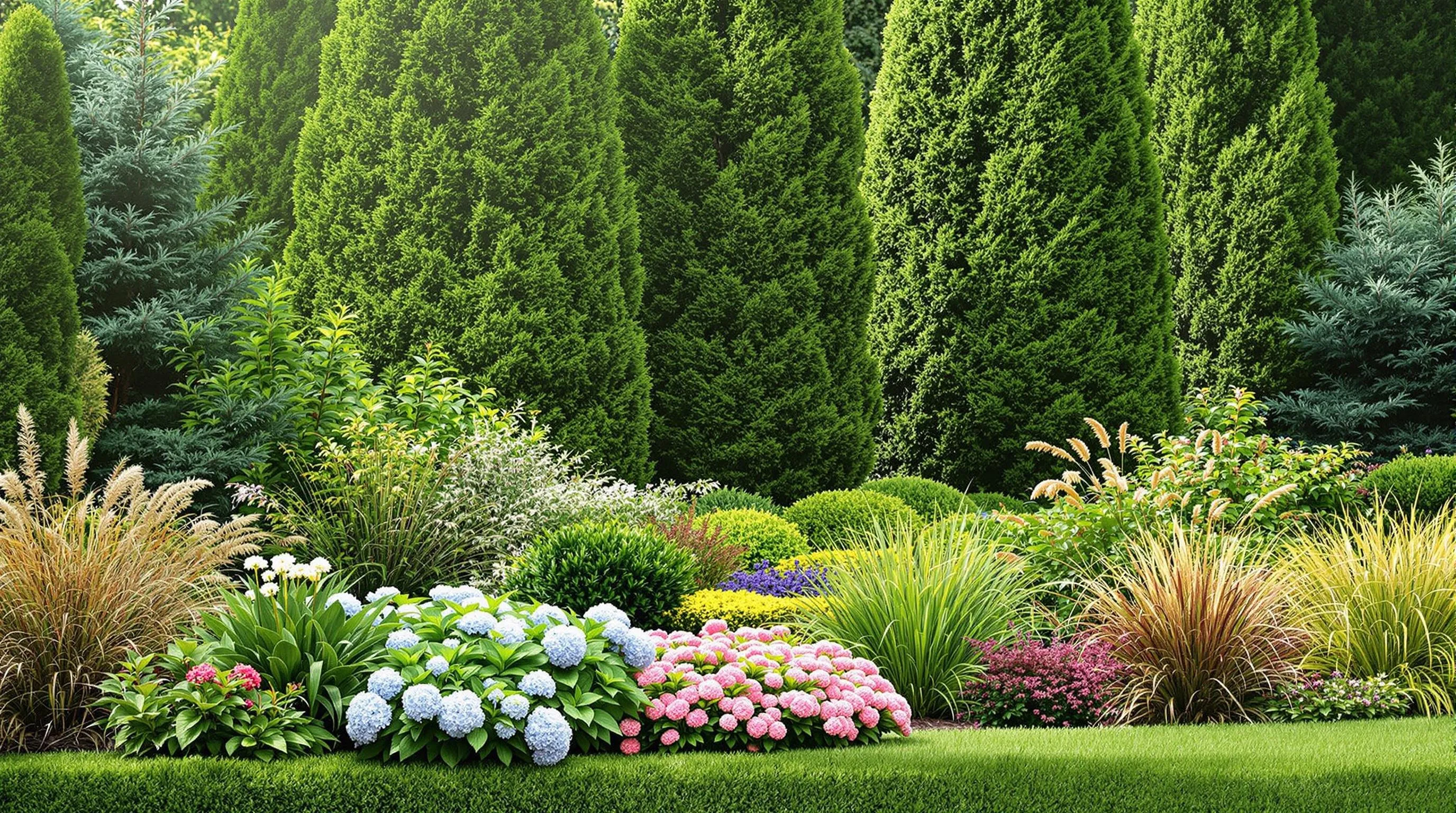
Creating a garden that maintains its beauty through all seasons requires strategic incorporation of evergreen foliage. These reliable plants form the backbone of year-round garden interest, providing structure and color even during winter months when deciduous plants have shed their leaves.
Winter-Hardy Evergreen Selections
Select climate-appropriate evergreens that can withstand your region’s coldest temperatures for reliable winter performance. Boxwood varieties like ‘Winter Gem’ and ‘Green Velvet’ offer compact forms perfect for borders and formal designs, withstanding temperatures down to -20°F. For textural diversity, incorporate Blue Star Juniper with its distinctive steel-blue needles and mounding habit, or Japanese Plum Yew (Cephalotaxus harringtonia) which thrives in shade and resists deer browsing. Broadleaf evergreens like Oregon Grape (Mahonia aquifolium) add dimension with their holly-like foliage that turns burgundy in winter, plus yellow spring flowers. In warmer zones, Southern Magnolia cultivars like ‘Little Gem’ provide glossy, deep green leaves with coppery undersides, creating dramatic contrast year-round.
Layering Deciduous and Evergreen Plants
Master the art of layering by combining evergreen foundations with seasonal deciduous highlights for ever-changing visual interest. Position structural evergreens like Hinoki Cypress or Yew as anchoring background elements, then surround them with deciduous shrubs like Oakleaf Hydrangea or Fothergilla that offer spectacular seasonal color changes. Interplant with herbaceous perennials such as Heuchera and ornamental grasses that die back in winter but leave attractive seed heads. This strategic layering creates a garden that shifts and transforms through seasons while maintaining its fundamental structure. The evergreen elements provide reliable form during winter months when deciduous plants enter dormancy, while deciduous specimens offer changing seasonal interest through new growth, summer foliage, fall color, and distinctive branch architecture. This thoughtful combination ensures your garden remains visually compelling throughout the entire year.
Crafting Peaceful Shade Gardens With Lush Foliage
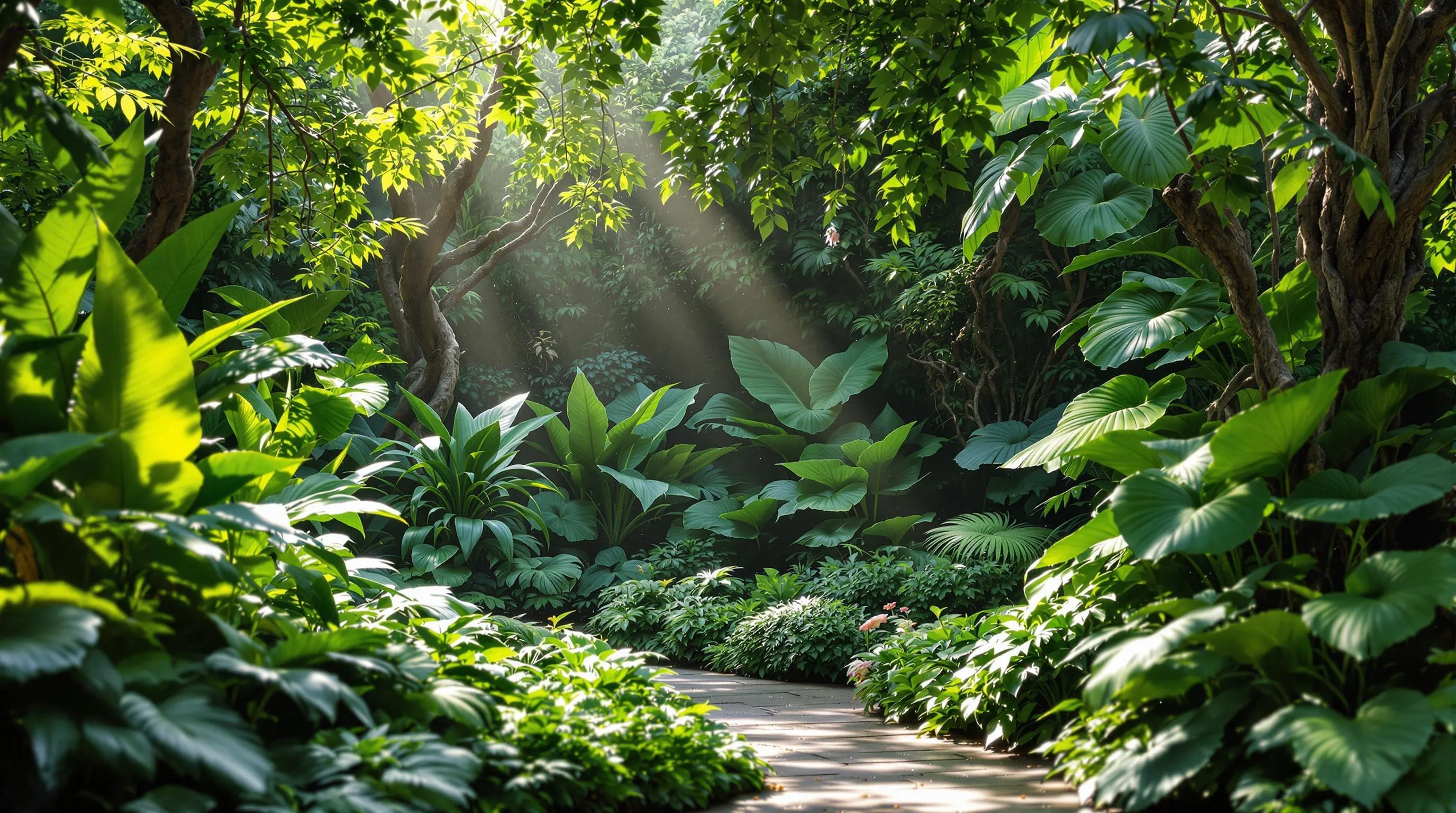
Shade gardens offer a cool retreat from summer heat while showcasing the beauty of foliage plants that thrive in dappled light. These tranquil spaces rely on texture and form rather than bright blooms to create interest and dimension.
Fern Varieties for Cool, Woodland Settings
Ferns are the quintessential shade garden plants, bringing delicate texture and prehistoric charm to woodland settings. Japanese Painted Ferns (Athyrium niponicum) offer striking silver-pewter fronds with burgundy highlights that brighten dark corners. For dramatic vertical impact, try the Ostrich Fern (Matteuccia struthiopteris) with its vase-shaped growth reaching 3-5 feet tall. The evergreen Christmas Fern (Polystichum acrostichoides) provides year-round structure with its leathery, deep green fronds that remain attractive through winter. For ground coverage, the delicate Maidenhair Fern (Adiantum pedatum) creates a soft carpet with its fan-shaped fronds on black stems. Mix different fern varieties for a multi-layered effect that mimics natural woodland understories while maintaining visual cohesion through their shared feathery textures.
Large-Leaved Plants for Tropical Ambiance
Large-leaved foliage plants instantly transform shade gardens into lush tropical retreats. Elephant ears (Colocasia and Alocasia) command attention with their massive heart-shaped leaves spanning up to 2 feet across in striking colors from lime green to nearly black. Pair these with the dramatic pleated leaves of Hosta ‘Empress Wu’ or ‘Blue Mammoth’ which can reach 18 inches long. For exotic appeal, incorporate Ligularia ‘The Rocket’ with its huge, serrated leaves and bold yellow flower spikes. Rodgersia varieties offer impressive compound leaves with interesting bronze tints when young. Position these statement plants where their dramatic silhouettes can be appreciated, using their oversized leaves to create depth and dimension in shaded spaces. The contrast between these bold specimens and more delicate shade plants creates a ever-changing garden that feels both peaceful and exotic.
Implementing Low-Maintenance Foliage Garden Designs
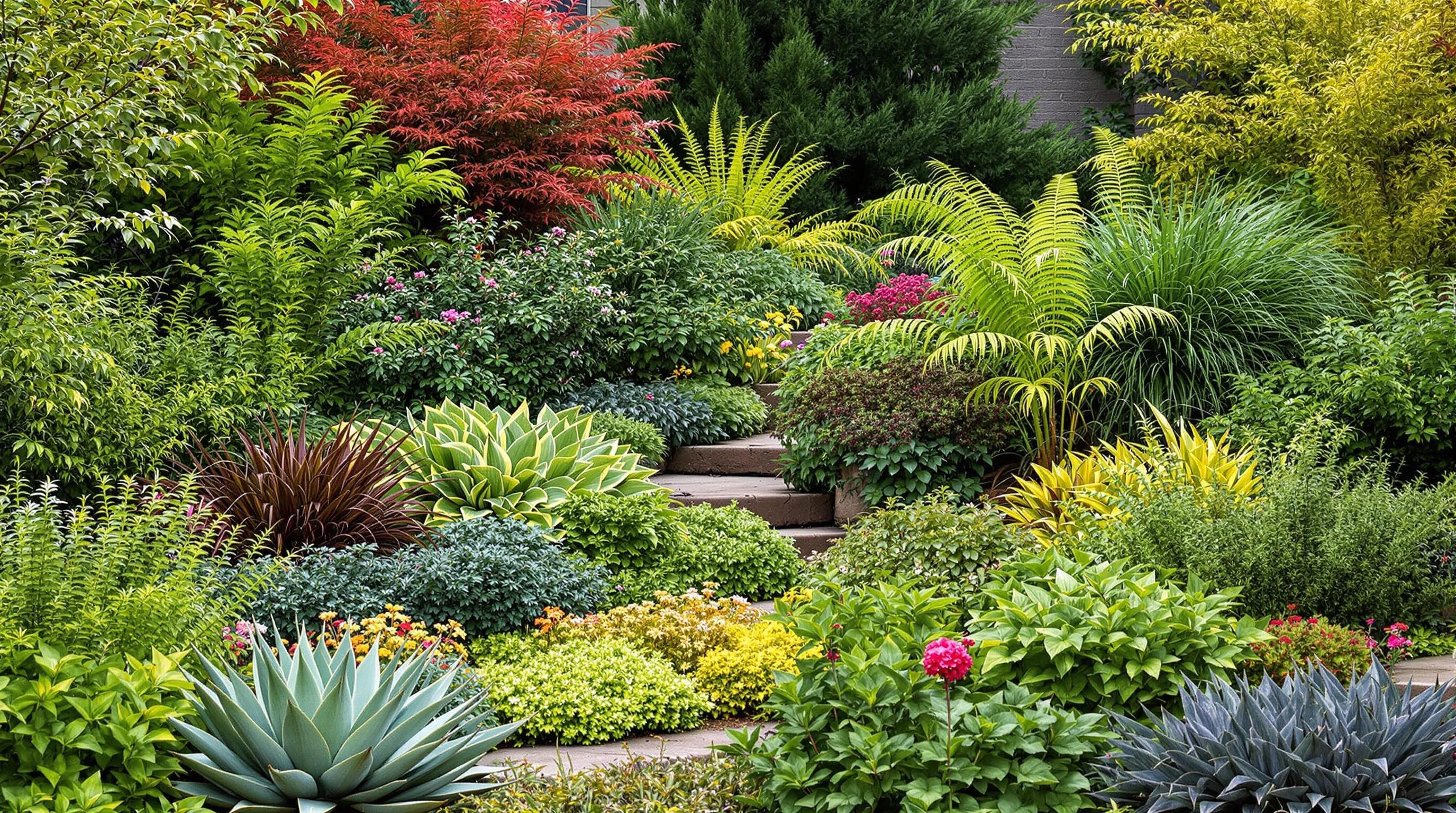
Creating a stunning foliage garden doesn’t have to mean endless hours of maintenance. By selecting the right plants and implementing smart design strategies, you can enjoy lush, textural landscapes that practically take care of themselves.
Drought-Tolerant Foliage Plant Options
Drought-tolerant foliage plants form the backbone of any low-maintenance garden, offering striking visual appeal with minimal watering needs. Consider adding Sedum ‘Autumn Joy’ with its succulent blue-green leaves that transform to deep burgundy in fall. Agave varieties deliver bold architectural statements with their striking rosettes and require almost no maintenance once established. Lamb’s ears (Stachys byzantina) provides soft, silvery-gray foliage that adds textural contrast while thriving in dry conditions. For larger spaces, ornamental grasses like Blue Fescue (Festuca glauca) and Mexican Feather Grass (Nassella tenuissima) create movement and drama without demanding constant attention. Plant these drought-resistant options in well-draining soil and group them according to water needs to create efficient, striking garden beds that won’t wilt during dry spells.
Native Foliage Plants for Easy Care
Native foliage plants offer unparalleled ease of maintenance while supporting local ecosystems. Once established, natives like Bearberry (Arctostaphylos uva-ursi) provide attractive ground cover with minimal intervention, having evolved to thrive in your exact climate and soil conditions. Virginia Sweetspire (Itea virginica) delivers multi-season interest with glossy green summer foliage that transforms to brilliant red-purple in autumn. For woodland settings, Christmas Fern (Polystichum acrostichoides) maintains year-round evergreen presence without demanding special care. Native shrubs like Ninebark (Physocarpus opulifolius) offer colorful foliage options ranging from deep purple to golden yellow, depending on the cultivar, while requiring virtually no maintenance once established. By choosing plants naturally adapted to your region, you’ll significantly reduce watering, fertilizing, and pest management efforts while creating a resilient garden that connects harmoniously to the surrounding industry.
Creating Stunning Container Displays With Foliage Plants
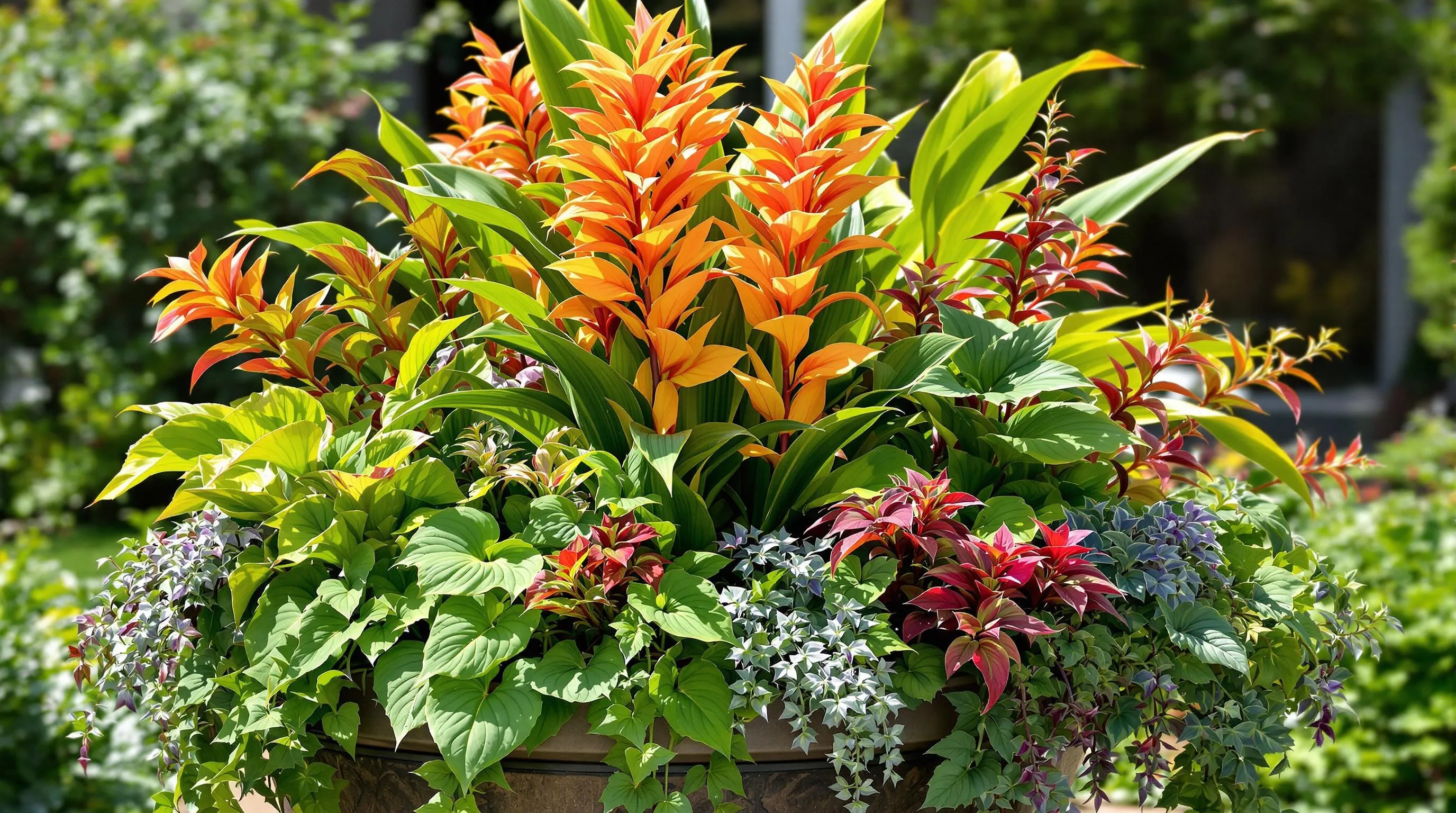
Container gardening offers endless possibilities for showcasing the beauty of foliage plants, even in limited spaces. With thoughtful design and plant selection, your containers can become stunning focal points in any garden setting.
Thriller, Filler, and Spiller Technique
The thriller, filler, and spiller technique creates ever-changing container arrangements with perfect visual balance. Start with a “thriller” – a tall, architectural plant like Canna ‘Tropicanna’ or Cordyline ‘Red Star’ positioned at the center or back of your container. Surround this focal point with “fillers” such as Coleus ‘Wasabi’ or Heuchera ‘Palace Purple’ that add mass and contrasting textures. Complete the design with “spillers” like Sweet Potato Vine ‘Blackie’ or Dichondra ‘Silver Falls’ that cascade over the edges, softening the container’s lines. This three-part formula ensures your foliage containers have height, fullness, and movement for maximum visual impact.
Season-Long Container Combinations
Create containers that maintain interest throughout multiple seasons by selecting foliage plants with complementary growth habits and hardiness levels. Combine evergreen shrubs like compact Boxwood or Japanese Holly with semi-evergreen perennials such as Heuchera ‘Caramel’ and Carex ‘Evergold’ for structure. Add seasonal interest with changeable elements like purple Ajuga in spring, colorful Coleus in summer, and ornamental kale in fall. Focus on contrasting leaf shapes and colors—pair the broad leaves of Bergenia with feathery Japanese Forest Grass and trailing Ivy for textural diversity. For year-round appeal in cold climates, incorporate dwarf conifers like Chamaecyparis ‘Gold Mop’ that maintain their color even during winter months.
Embracing Architectural Plants for Structure
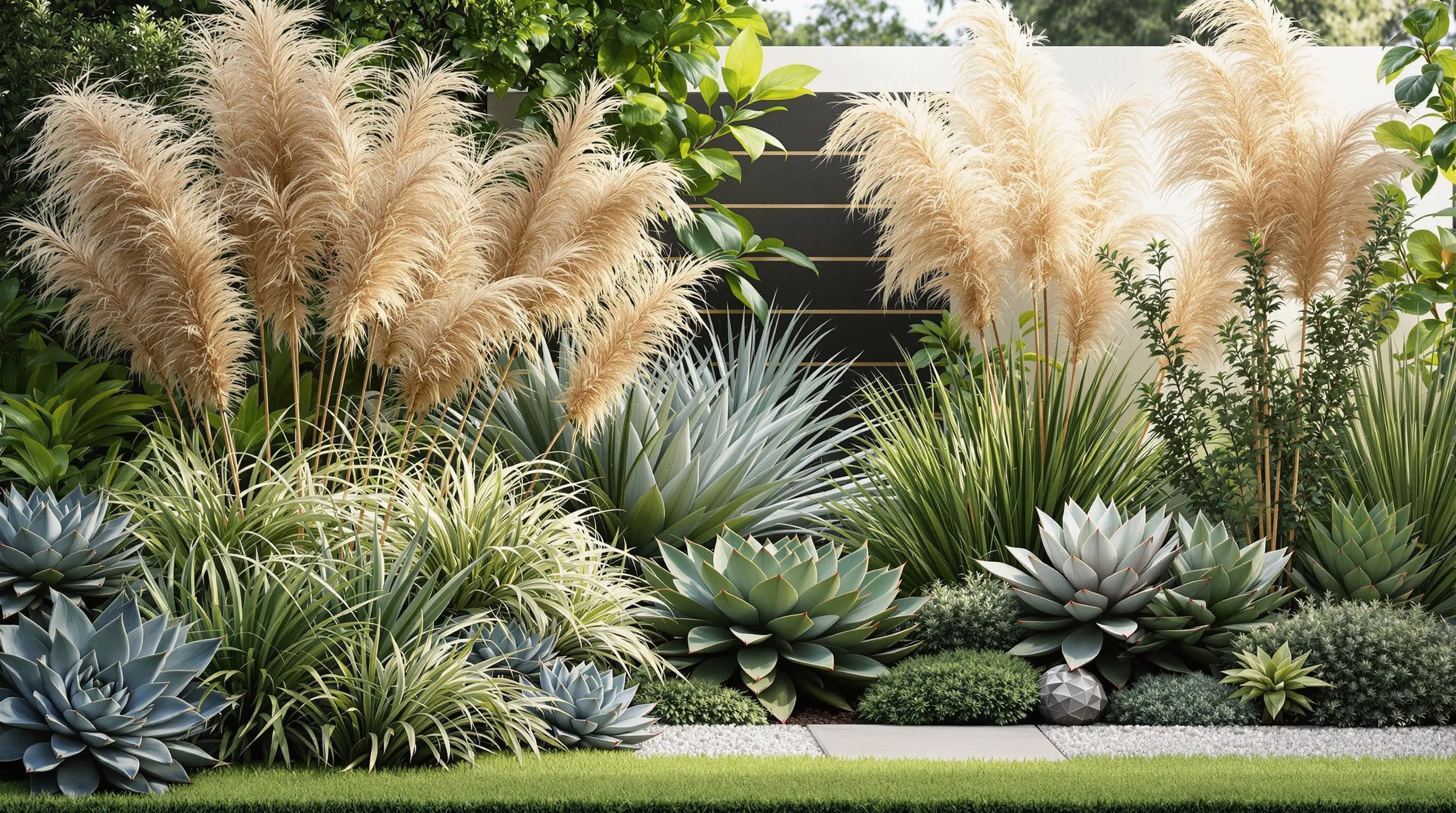
Architectural plants serve as the backbone of foliage gardens, creating strong visual impact through distinctive shapes and commanding presence. These structural elements provide year-round interest and establish a framework around which other plantings can be organized.
Ornamental Grasses for Movement and Form
Ornamental grasses bring ever-changing movement and sculptural form to foliage gardens, creating visual interest that changes with the seasons. Tall varieties like Miscanthus sinensis ‘Gracillimus’ and Calamagrostis x acutiflora ‘Karl Foerster’ provide vertical structure with their upright habits, forming elegant backdrops that sway gracefully in the slightest breeze. For mid-height structure, consider Pennisetum alopecuroides ‘Hameln’ (Dwarf Fountain Grass) with its fountain-like form and fluffy seedheads that catch morning dew. Low-growing options such as Festuca glauca ‘Elijah Blue’ offer compact mounds of blue-gray foliage that create textural contrast at garden edges. The seasonal transformation of ornamental grasses—from fresh spring growth to summer fullness, autumn color, and winter silhouettes—ensures continuous visual appeal throughout the year.
Structured Succulents for Modern Gardens
Structured succulents deliver bold architectural elements with their geometric forms and striking symmetry, perfect for contemporary garden designs. Agave americana creates dramatic impact with its massive rosette of thick, pointed leaves, while Echeveria varieties form perfect living sculptures with their compact, rosette shapes. For vertical interest, incorporate Euphorbia tirucalli ‘Sticks on Fire’ with its coral-colored upright stems that create a fascinating architectural statement. These drought-tolerant plants maintain their distinctive shapes year-round with minimal maintenance, making them ideal for busy gardeners. Their clean lines and sculptural qualities create focal points that contrast beautifully with softer foliage elements, adding a modern edge to your garden design. Position structured succulents strategically to emphasize pathways, highlight garden rooms, or create striking vignettes that draw the eye through the industry.
Designing Specialized Foliage Gardens
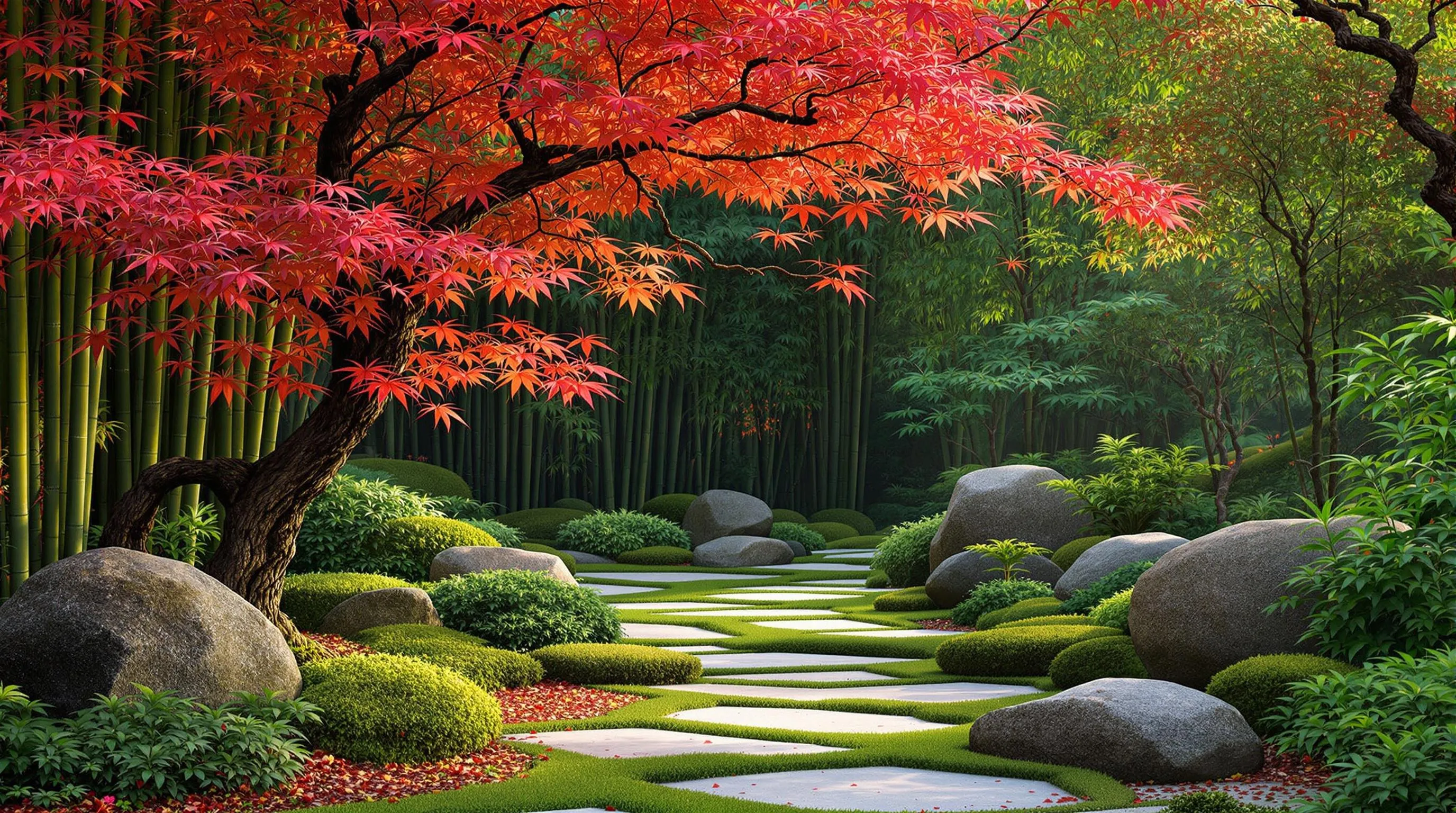
Japanese-Inspired Foliage Gardens
Japanese-inspired foliage gardens create tranquil, meditative spaces through careful plant selection and mindful arrangement. Start with foundation plants like Japanese maples (Acer palmatum) with their delicate, star-shaped leaves that provide stunning red, orange, or purple foliage. Integrate bamboo varieties such as Fargesia rufa for vertical structure without invasive tendencies. Layer with shade-loving ground covers like Hakone grass (Hakonechloa macra ‘Aureola’) that mimics flowing water with its graceful, arching habit. Include mosses such as cushion moss (Leucobryum glaucum) to soften pathways and create authentic Japanese aesthetics. For structural elements, incorporate carefully pruned evergreens like Hinoki cypress (Chamaecyparis obtusa ‘Nana Gracilis’) or Japanese plum yew (Cephalotaxus harringtonia). Complete your design with large feature stones positioned asymmetrically to represent mountains or islands, creating the essential Japanese garden philosophy of representing nature in miniature form.
Tropical Foliage Retreats in Temperate Climates
Creating tropical foliage retreats in cooler regions requires strategic plant selection and thoughtful design techniques. Choose cold-hardy plants with tropical appearances, like Japanese banana (Musa basjoo) which can survive temperatures down to 0°F when properly mulched. Incorporate large-leaved perennials such as Rodgersia and Ligularia ‘The Rocket’ that mimic tropical foliage but thrive in cooler conditions. Hardy palms like windmill palm (Trachycarpus fortunei) and needle palm (Rhapidophyllum hystrix) add authentic tropical structure while tolerating frost. Layer with broad-leaved evergreens such as Fatsia japonica and Aucuba japonica ‘Variegata’ for year-round tropical effects. For seasonal impact, use tender tropical plants like elephant ears (Colocasia) and cannas as summer container specimens that can be overwintered indoors. Create a microclimate by positioning your tropical garden against a south-facing wall and adding strategic windbreaks to trap heat, allowing you to grow more tender specimens than your hardiness zone typically permits.
Choosing the Right Foliage Plants for Your Growing Conditions
Your foliage garden is more than just a collection of leafy plants—it’s a living canvas that transforms your outdoor space into a textural wonderland. By embracing the diverse industry of foliage plants you’ve created a industry that delivers year-round interest with minimal maintenance.
Whether you’ve opted for dramatic height variations architectural specimens or peaceful shade retreats remember that the perfect foliage garden reflects your personal style while respecting your site’s conditions. The beauty lies in the endless possibilities—from Japanese-inspired tranquility to bold tropical statements.
Let your foliage garden evolve with the seasons celebrating the changing textures colors and forms. With thoughtful plant selection and creative design your leafy retreat will continue to inspire and delight for years to come.

